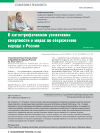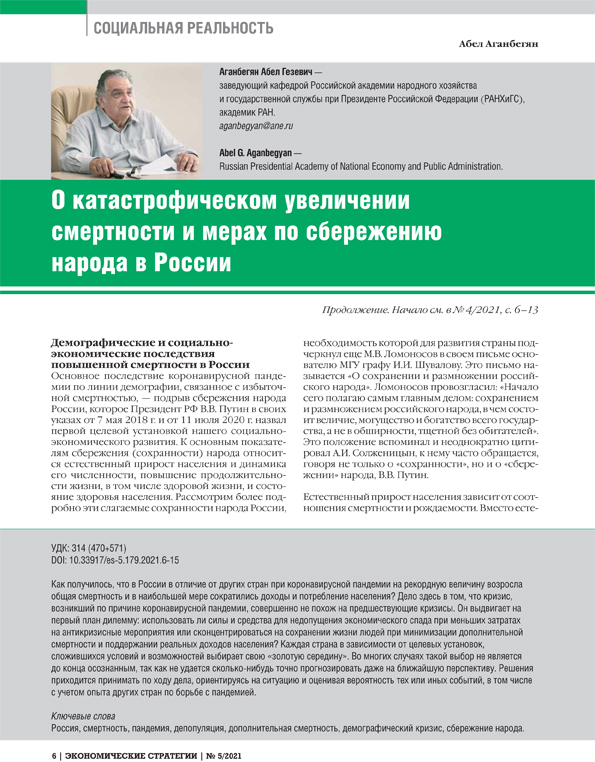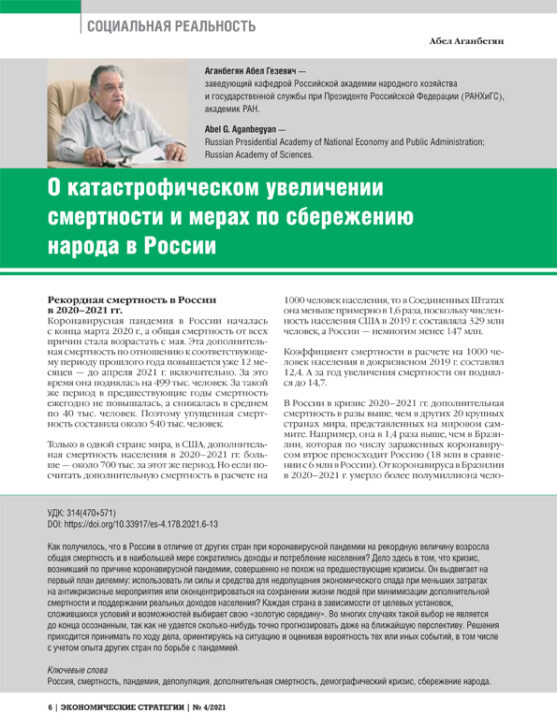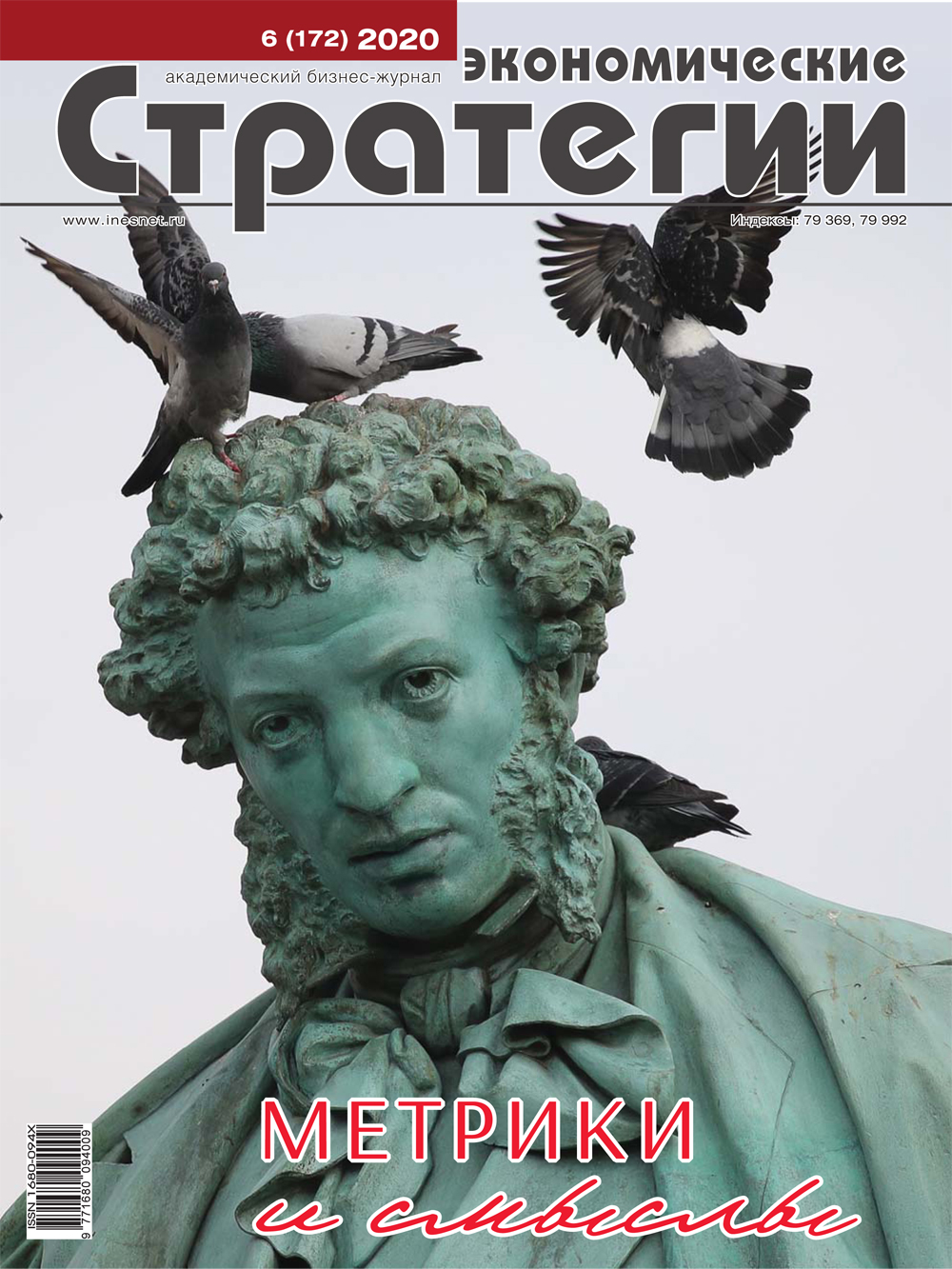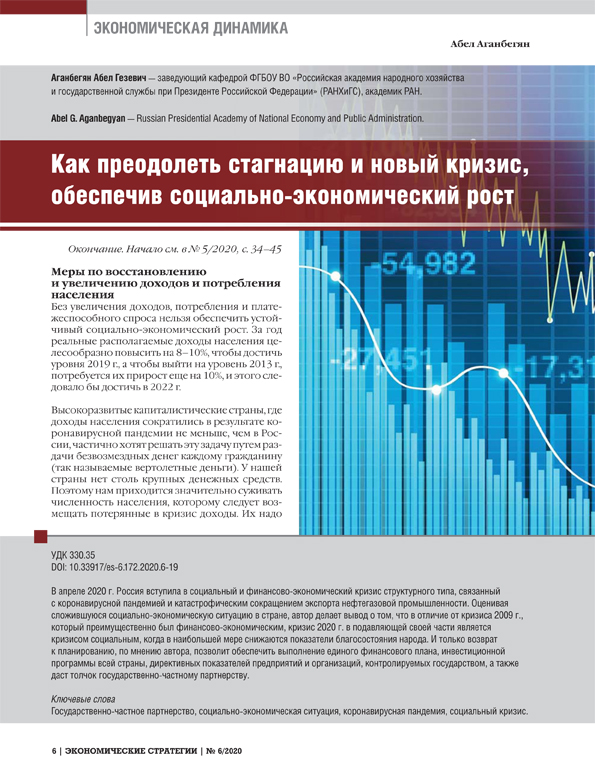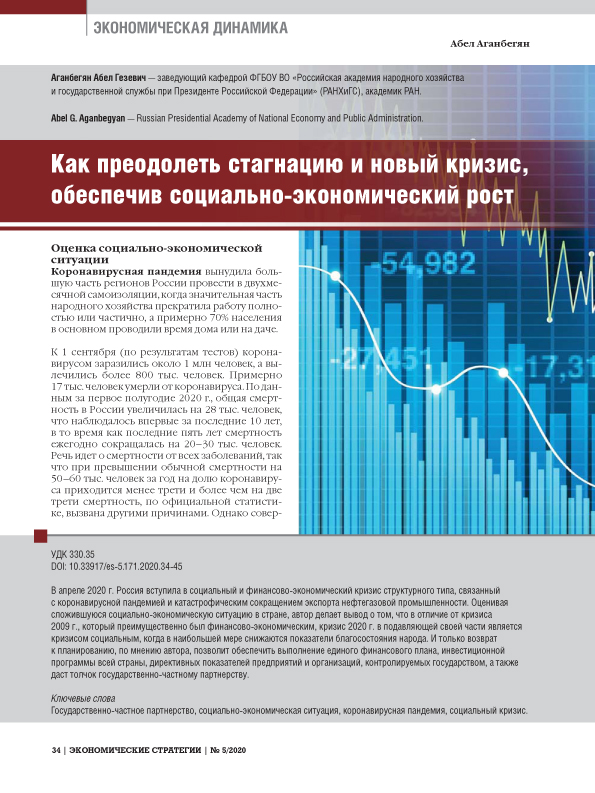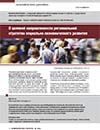Author page: Abel Aganbegyan
Reducing Catastrophically High Mortality Rate and Restoring the Undermined Safety of the Russian People
On Catastrophic Increase in Mortality and Measures to Save the People in Russia
DOI: https://doi.org/ 10.33917/es-5.179.2021.6-15
How is it that in Russia, unlike in other countries, during the coronavirus pandemic the total mortality increased by a record amount and the income and consumption of the population decreased to the greatest extent? The point is that the crisis, caused by the coronavirus pandemic, is completely different from previous ones. It highlights the dilemma: should we use forces and means to prevent an economic recession with lower costs for anti-crisis measures, or focus on saving people’s lives while minimizing additional mortality and maintaining real incomes of the population? Each country, depending on objectives, prevailing conditions and opportunities, chooses its “golden mean”. In many cases such choice is not fully conscious, since it’s not possible to forecast with any certainty even over the near term. Decisions have to be taken up along the way, based on the situation and assessing the probability of certain events, including in view of the other countries’ experience in combating the pandemic.
On Catastrophic Increase in Mortality and Measures to Save the People in Russia
DOI: https://doi.org/ 10.33917/es-5.179.2021.6-15
How is it that in Russia, unlike in other countries, during the coronavirus pandemic the total mortality increased by a record amount and the income and consumption of the population decreased to the greatest extent? The point is that the crisis, caused by the coronavirus pandemic, is completely different from previous ones. It highlights the dilemma: should we use forces and means to prevent an economic recession with lower costs for anti-crisis measures, or focus on saving people’s lives while minimizing additional mortality and maintaining real incomes of the population? Each country, depending on objectives, prevailing conditions and opportunities, chooses its “golden mean”. In many cases such choice is not fully conscious, since it’s not possible to forecast with any certainty even over the near term. Decisions have to be taken up along the way, based on the situation and assessing the probability of certain events, including in view of the other countries’ experience in combating the pandemic.
On Catastrophic Increase in Mortality and Measures to Save the People in Russia
DOI: https://doi.org/10.33917/es-4.178.2021.6-13
How is it that in Russia, unlike in other countries, during the coronavirus pandemic the total mortality increased by a record amount and the income and consumption of the population decreased to the greatest extent? The point is that the crisis, caused by the coronavirus pandemic, is completely different from previous ones. It highlights the dilemma: should we use forces and means to prevent an economic recession with lower costs for anti-crisis measures, or focus on saving people’s lives while minimizing additional mortality and maintaining real incomes of the population? Each country, depending on objectives, prevailing conditions and opportunities, chooses its “golden mean”. In many cases such choice is not fully conscious, since it’s not possible to forecast with any certainty even over the near term. Decisions have to be taken up along the way, based on the situation and assessing the probability of certain events, including in view of the other countries’ experience in combating the pandemic.
How to Overcome Stagnation and New Crisis, Providing Socio-Economic Growth
DOI: 10.33917/es-6.172.2020.6-19
In April 2020, Russia entered a structural social and financial-economic crisis caused by the coronavirus pandemic and catastrophic decline of oil and gas exports. Assessing the current socio-economic situation in the country, the author concludes that, in contrast to the crisis of 2009, which was mainly financial and economic in nature, the 2020 crisis for the most part has got a social character, when indicators of the people’s well-being are declining particularly. According to the author, only return to planning would ensure implementation of an integrated financial plan, an investment program for the whole country, directive indicators of enterprises and organizations controlled by the state, as well as would impact public-private partnership.
How to Overcome Stagnation and New Crisis, Providing Socio-Economic Growth
DOI: 10.33917/es-5.171.2020.34-45
In April 2020, Russia entered a structural social and financial-economic crisis caused by the coronavirus pandemic and catastrophic decline of oil and gas exports. Assessing the current socio-economic situation in the country, the author concludes that, in contrast to the crisis of 2009, which was mainly financial and economic in nature, the 2020 crisis for the most part has got a social character, when indicators of the people’s well-being are declining particularly. According to the author, only return to planning would ensure implementation of an integrated financial plan, an investment program for the whole country, directive indicators of enterprises and organizations controlled by the state, as well as would impact public-private partnership
On the Target Orientation of a Regional Strategy for Socio-Economic Development
DOI: 10.33917/es-1.167.2020.6-17
In the second part of the article, as an example of regional strategies of the Vladimir, Kostroma, Irkutsk regions of Russia, Trans-Baikal Territory and St. Petersburg, as well as regional strategies for the Kyzylorda and Akmola regions of Kazakhstan, the author examines the level of social development of the region and assesses its target orientation to improve the welfare of its population. It is concluded that the preservation of the health of the population, especially children and able-bodied citizens, is the highest goal in the field of improving welfare
On the Target Orientation of a Regional Strategy for Socio-Economic Development
DOI: 10.33917/es-8.166.2019.6-15
When you get acquainted with regional strategies, you see that their authors usually try to formulate several tasks that cover
all aspects of society. For example, increasing the region’s competitiveness or raising the level of culture, etc. Thus, attention is focused on a number of tasks that are actually subordinate to these two main tasks mentioned above. Each strategy is always focused on improving the living standards of the region’s population. But almost never we see inside the
strategy specific tasks to increase this region’s contribution to socio-economic development of the country. This contribution
doesn’t mean an increase in the specific gravity of the region, for example, in creating the country’s gross domestic product,
but usually it is much higher due to those industries and areas of specialization in which the region plays a major role.
Many consider it extremely important that each of these tasks, which they list in the usual regional strategy, be divided into
subtasks, and those, in turn, into smaller tasks. As a result, several dozen tasks of the region are formulated, which are usually not specifically applied to any large enterprise or organization of this region, but to the activity direction. For example, the task of developing physical education or improving the population’s nutrition, etc. is highlighted.
Such approach in terms of system analysis seems to be very important, but in fact it is quite formal. And this formality tends
to obscure analytics — the main method necessary for serious strategy development. Based on considerable experience in developing strategy of the Russian regions — Vladimir, Kostroma, Irkutsk regions and the Trans-Baikal Territory, St. Petersburg, as well as regional strategies for Kazakhstan — for the Kyzylorda region and the capital Akmola region, the author of the article proposes a methodology for developing the region’s strategy taking into account its contribution into the country’s socio-economic development
Methods of Digital Economy in Terms of Management and Control Activities in the Real Economy
DOI: 10.33917/es-4.162.2019.42-49
The regular meeting of the Bogomolov Club, held on April 1, 2019 at the Institute for Economic Strategies, was dedicated to discussing the state, prospects and drivers of Russia’s socio-economic growth. The keynote address was made by the Chairman of the Club academician Abel Gezevich Aganbegyan.







